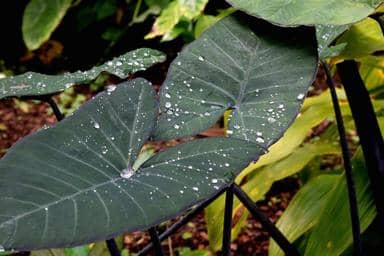Are you looking for a new addition to your garden? Have you considered investing in some elephant ear bulbs? These plants don’t bloom, but they have beautiful, large, and lush leaves.
Also, they’re available in a range of colors and shapes, so you have a ton of options to choose from.
Their leaves can be anywhere from dark green to lime green to purple. And even though each leaf can grow up to several feet wide, you don’t need a large garden to get them. You can plant elephant ear bulbs in containers like pots.
Some people tend to think these plants are tricky to grow, but that simply isn’t true. Much like other plants, all you need is the right information about where and how to grow them. As long as you have that, your elephant ear bulbs will grow and be healthy.
Here’s everything you need to know about planting elephant ear bulbs in pots.

Things You’ll Need
The first thing you need to do is run to a store and buy the following:
- Pot
- Gardening gloves
- Shears
- Potting mix
- Manure
- Elephant ear bulb
- Fertilizer
- Water
Potting An Elephant Ear Bulb
Once you’ve got everything on the list, you can move on to potting the bulb.
Step 1: Getting The Right Pot
While you don’t need a large garden to grow elephant ear bulbs, you do need a large pot if you want to grow them in a container. The specific size of this pot depends on the type you’re purchasing.
Pots for Alocasia cultivars need to be at least 36 inches wide. On the other hand, you can manage with an 18 inches wide and 16 inches deep pot for Colocasia species.
If you want to get a smaller pot at the start and then move your plant as it grows, you can do that too. Ask the person in charge at the garden nursery for the size of the pot the elephant earbud was in when you’re buying it.
Then get a container that is at least 2 inches bigger than it. This should be a good place to start.
However, we don’t recommend doing this. You’ll have to re-pot often and get new pots every couple of weeks.
Additionally, you will find yourself spending a lot of time watering the pot. Elephant ear plants prefer consistently moist soil, and smaller pots dry quickly. Having a larger container means you don’t need to water as often.
The moisture requirement also means that you should look at pots made of non-porous materials like plastic and glazed clay. They encourage water retention. However, drainage holes are also important.
While elephant ears like moist soil, they do not like standing water. That harms them and stifles growth.

Step 2: Filling The Pot
Once you’ve got your hands on the perfect pot, it is time to plant your bulb. Fill three quarters of the pot with a commercial potting mix. While you can get any company’s product, check the ingredient list to see it has sand, vermiculite, and peat moss.
These three ingredients create a mixture that provides the ideal balance between drainage and moisture retention, fostering excellent plant growth.
Some products have fertilizers, nutrients, and other such ingredients. They aren’t harmful to elephant ears, and you can add them without worry. However, steer clear of any potting mix with clay.
They’re heavy, store too much water, and are bad for elephant ears. It is very easy to overwater a plant with a clay potting mix. You don’t want to take that risk.
Once that’s done, add an even layer of organic compost. This will give extra nutrients and make sure that your bulb grows into a healthy plant.
The last thing to do in this step is burying your bulb. Dig an 8-inch hole in the pot’s middle and place the bulb in it. Keep the flat end of the root pointing down. If you bought an established plant, make sure you bury the plant at the same soil line as in the nursery.
We recommend only planting one bulb in one pot. The plant will spread a lot and need space. So unless you’re working with a huge pot, there won’t be enough space for two or more bulbs in one container.
Recommended Potting Mix
| Image | Title | Prime | Buy |
|---|---|---|---|
 Top
Top
Top
Top | Miracle-Gro Potting Mix 2 cu. ft. | PrimeEligible | Check Price on Amazon |
 Top
Top
Top
Top | Burpee Premium Organic Potting Mix, 9 quart | PrimeEligible | Check Price on Amazon |
Top Top
Top
Top
Top | FoxFarm Ocean Forest Potting Soil Mix Indoor Outdoor for Garden and Plants | Plant Fertilizer | 12 Quart + THCity Stake | PrimeEligible | Check Price on Amazon |
 | Espoma Organic Potting Soil Mix - All Natural Potting Mix For Indoor & Outdoor Containers For Organic Gardening, 8 qt, Pack of 1 | PrimeEligible | Check Price on Amazon |
 | Miracle-Gro Indoor Potting Mix 6 qt., Grows beautiful Houseplants | PrimeEligible | Check Price on Amazon |
 | House Plant and Tropical Plant Potting Soil - Re-Potting Soil for All Types of Indoor House Plants, House Plant Re-Potting Soil - 8QTs | PrimeEligible | Check Price on Amazon |
 | Espoma 16 qt. Organic Seed Starter Premium Potting Mix (2) | Prime | Check Price on Amazon |
 | Fort Vee Compost-Based Potting Mix, 18 Pounds, Organic Nutrient-Boosted Potting Mix | Prime | Check Price on Amazon |
Step 3: Choosing The Best Spot to Place The Pot
Each type of elephant bulb needs a different amount of sunlight, so you will have to check the specific requirements of the variety you’re growing. However, most need at least 6 to 8 hours which is typically referred to as ‘full sunlight.’ Colocasias fall in this category.
Even so, there are some subtypes like Alocasias that thrive with only two hours of sunlight a day.
If you ever see your elephant ear’s leaves looking brown or bleached, that means your plant is getting more sun than it needs. Immediately take it to an area that doesn’t receive as much sunlight and give the plant a break.
Taking Care of Your Plant
The third part of getting an elephant ear bulb is taking care of your plant after you have potted it.
1. Water
When watering your plant, you can’t have specific measured amounts of how much water you should give it. It depends on a lot of variables like how hot it is or how much humidity you’re dealing with.
The best way to judge it is by feel. Your plant should be moist but not soggy. You can tell if you’re doing it right by feeling the soil in the container. Do it every day to see if the soil is drying out. Only water when it feels dry. Never water too much pre-emptively.
If you add extra water today, it will not save you from having to water again in a couple of days. Instead, it will kill your plant because overwatering is a fatal mistake.
We can not stress the importance of not letting your plant dry out enough. Elephant ears grow fast. They always need water at hand and get stressed if their soil doesn’t have it.
2. Feed
You also need to feed your elephant ears. After every four weeks or one month, use a balanced fertilizer to satiate your plant. A balanced fertilizer is one that has equal amounts of nitrogen, potassium, and phosphate.
This could be a 10-10-10, which has 10% of each one of the three substances, or a 20-20-20, which has 20% of each.
Recommended Fertilizers
| Image | Title | Prime | Buy |
|---|---|---|---|
 Top
Top | Purived Liquid Fertilizer for Indoor Plants | 20oz Concentrate | Makes 50 Gallons | All-Purpose Liquid Plant Food for Potted Houseplants | All-Natural | Groundwater Safe | Easy to Use | Made in USA | PrimeEligible | Check Price on Amazon |
Top | FoxFarm Liquid Nutrient Trio Soil Formula: Big Bloom, Grow Big, Tiger Bloom (Pack of 3-16 oz Bottles) 1 Pint Each + Twin Canaries Chart | PrimeEligible | Check Price on Amazon |
 Top
Top | Garden Alchemy: 80 Recipes and Concoctions for Organic Fertilizers, Plant Elixirs, Potting Mixes, Pest Deterrents, and More | Prime | Check Price on Amazon |
 Top
Top | Espoma Garden-Tone Plant Food, Natural & Organic Fertilizer for an Abundant Harvest, 4 lb, Pack of 1 | PrimeEligible | Check Price on Amazon |
 | J R Peters 52024 Jacks Classic No.1.5 20-20-20 All Purpose Fertilizer | PrimeEligible | Check Price on Amazon |
 | Joyful Dirt Organic Based Premium Concentrated House Plant Food and Fertilizer. Easy Use Shaker (3 oz) | PrimeEligible | Check Price on Amazon |
 | Indoor Plant Food | All-purpose House Plant Fertilizer | Liquid Common Houseplant Fertilizers for Potted Planting Soil | by Aquatic Arts | PrimeEligible | Check Price on Amazon |
3. Prepare for Cold Months
Autumn is super hard on plants. They stop growing because of the drop in temperatures. At this point, you need to prune the dead foliage and stop watering completely. Use shears for this step.
Some parts of the world don’t have four seasons. They don’t get Autumn. If you live in one of these areas, you don’t have to worry about pruning. Ignore this step and the next. They aren’t relevant to you or your elephant ears. Continue the normal feeding and watering routine.
However, if you do have Autumn, you can use this time to repot your plant if needed. They won’t be disturbed a lot at this time.
You should also bring any elephant ear pots placed outside inside. Autumn is followed by winter, and extreme cold weather can be deadly for plants like these. They will dry out and not make it through the season.
Keep the pot in a dry and cool spot inside.
You may also be interested in…
4. Spring Months
As soon as you enter spring months following 2 to 2 ½ months of dormancy, you should start watering your elephant ears 1 to 2 times a month. This will keep the soil moist without letting the water stand and making the soil soggy.
You can start fertilizing again as well.
Frequently Asked Questions About Planting Elephant Ear Bulbs
Yes, these plants are toxic and should be kept away from children and pets. The leaves and stems are the most dangerous parts. Even touching them can cause itching and irritation. If you get the sap in your eyes, they will burn for several hours. So you should always wear gloves when working with it. However, elephant ear poisoning is very rarely fatal. The plant can only kill if you consume it in large amounts.
You should plan on giving your plant at least 2 to 3 inches of water every week. Elephant ears are heavy drinkers because they grow quickly. However, as mentioned before, watering has to be done by feel.
Yes, elephant ears are perennials.
If you follow our instructions and take proper care of your plant, it will take between 14 and 20 weeks to grow to full size.
You can plant them any time after winter when the threat of frost has passed. However, since they won’t grow until the soil is warm, it is fairly pointless to plant them until the soil is at least 65 degrees Fahrenheit. This typically happens around June.
An elephant’s ear’s leaves turn yellow when there is an issue with the watering. Their soil is probably dry a lot because of which their roots can not do enough active transport. If that happens, the leaves will not get nutrients and turn yellow. You should water more regularly to fix the issue.
Epsom salt will help your plant have dark and rich foliage.
Final Thoughts on How to Plant Elephant Ear Bulbs in Pots
Planting elephant ear bulbs is very simple if you have the right information. And this article has everything you need.
Start by getting the perfect pot, then plant the bud, and place it in a place with good exposure to sunlight.
Then water it regularly and feed it at spaced intervals. If you live in a place with four seasons, be prepared for Autumn and Winter. As long as you do these things, your plant will be healthy.
Reference
The Encyclopedia of Container Plants

Darrell has a passion for gardening that he inherited from his father. Go here to read more about the influence his father played in his love for gardening. If you want to send Darrell a quick message, then visit his contact page here.



![Container gardening for beginners [Buying guide]](https://wraxly.com/wp-content/uploads/2021/02/Container-gardening-for-beginners-Buying-guide-1200-1024x576.webp)